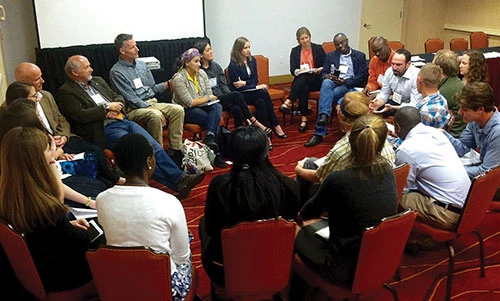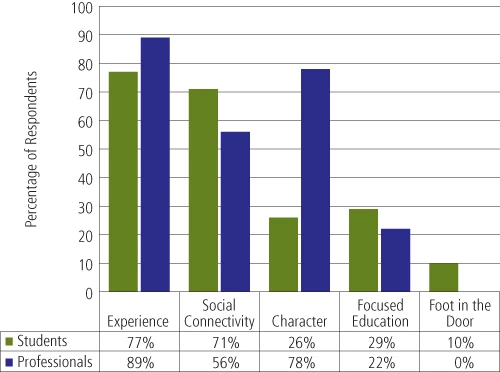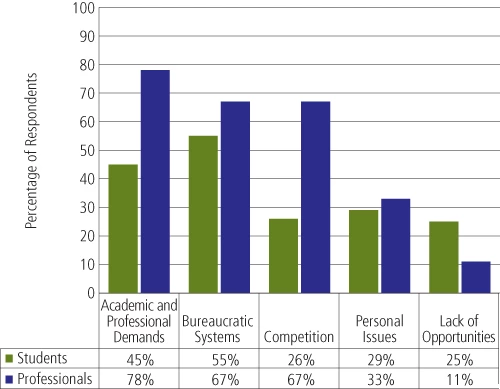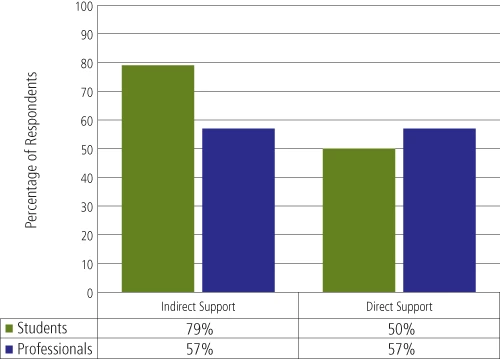Last updated: March 21, 2021
Article
Student and professional perspectives on park and protected area careers
By Matthew H. E. M. Browning, Jennifer M. Thomsen, and Wonjun Choi
The National Park Service (NPS) and similar bureaus and agencies are experiencing two overlapping constraints in job recruitment. First, young adults are having greater difficulties with securing jobs than people of other ages. Recent data from the US Bureau of Labor Statistics describe how unemployment rates for individuals in their early 20s are approximately 200% higher than those for individuals in their late 30s and 40s (BLS 2015). Thus, the many factors influencing job placement success for this generation of recent graduates have led to the highest peak in millennials making less than $25,000 per year in the past 25 years (Stahl 2015). The number of students seeking and earning advanced degrees has also significantly increased by more than 150% in recent years (NCES 2015), which further inflates job competition. This high level of job competition may be particularly strong in park and protected area fields that have experienced relatively flat budgets or budgets that have increased at a rate that has not kept up with the increased costs of labor. Such issues have prevented areas administered by the National Park Service, like the Blue Ridge Parkway, from filling more than 70 vacant positions since the early 2000s (Eilperin 2012). According to the NPS Office of Relevancy, Diversity, and Inclusion, only 4% of current NPS employees are 29 years old or younger (K. Reyes, workforce data analyst, NPS, e-mails with first author, 2 March 2016) while more than 20% of the US labor force is in this same age bracket and is gainfully employed (BLS 2015).
The second challenge regarding job recruitment is related to the large, impending turnover of employees due to baby-boomer retirements. This demographic, which consists of people born between 1946 and 1964, comprises 33% of today’s workforce (BLS 2015). As senior employees, however, these baby-boomers are disproportionately represented in upper management positions. Nearly 21% of all NPS managers were eligible to retire by the end of 2016. In contrast, only 15.8% of the nonmanagerial NPS employees could retire in the same timeframe (K. Reyes, workforce data analyst, NPS, e-mails with first author, 2 March 2016). These upper-level vacancies will simultaneously require internal readjustments as well as a host of new hires during a transition that will play out over the course of many years. The challenge is for agencies to plan ahead strategically for both coherence and continuity during this transition. As such, employers must focus on recruiting a large number of new employees with high leadership potential for rapid advancement. Recent graduates also need to set lower expectations for their first job. For example, while many recent graduates may have the skill set for higher-level positions, they may be best served by obtaining seasonal or temporary positions (Doyle et al. 1999). Students may be more receptive to this route if they have an understanding that the employer supports rapid upward mobility.
These two constraints provide a great opportunity for professional organizations such as the George Wright Society to help recent graduates be successful in entering park and protected area careers. Professional organizations might extend career services offered by higher education institutions (e.g., career workshops, education courses, practice interviews, and career fairs) but also informal networking opportunities to connect young adults with potential employers. For example, the International Association for Society and Natural Resources (IASNR) has a Student Affairs Committee and a “students” tab on their website for announcements, mentoring opportunities, and student-driven events at their annual forums to further collaboration and professional development. Similarly, the George Wright Society (GWS) offers an annual Park Break program that promotes a weeklong immersion experience for students to engage with professionals in the field around real-world issues in park and protected area management. Such opportunities would help young adults learn about employers’ expectations, prepare for the job application process, and build a professional social network. Additionally, these opportunities would help employers identify and recruit future young professionals qualified for their agencies with the appropriate skill set to be successful in their career (Sharp and Doucette 2014).
To gain a better understanding of these dynamics, we hosted a workshop and developed questionnaires to gather perspectives on park and protected area careers from both students and career professionals. Our three specific goals were to understand (1) what factors are needed for students to be successful in pursuing careers, (2) what constraints prevent students from obtaining and advancing in their careers, and (3) how professional organizations might simultaneously help students in their career pursuits and agencies in their recruitment of these students. We focused largely on currently enrolled undergraduate and graduate students, because we believed this cohort might be particularly competitive for related job openings. Furthermore, this cohort would be likely to fulfill agency needs for new employees with leadership potential. Professionals were also included in the study to offer their perceptions from the agency and organizational points of view.
Methods
The George Wright Society conference is a biennial event and one of North America’s premier interdisciplinary conferences on protected areas. It is attended by anywhere from 350 to more than 1,000 professionals (700 in 2015), of which approximately 50% are federal agency employees and as many as 100 are students (D. Harmon, executive director, GWS, e-mail to first author, 27 January 2016). At the 2015 GWS conference in Oakland, California, we organized a two-hour career-focused workshop (fig. 1). This workshop brought together 55 students and approximately 30 professionals to discuss different conservation careers, such as jobs with the National Park Service and other land management agencies, nonprofit organizations, and universities. Four “career sectors” related to the management of park and protected areas were discussed: governmental agencies, academic, nonprofit, consultant, and corporate. During the session, students rotated among groups of professionals to discuss the biggest challenges and opportunities of working in each of these sectors in addition to strategies for navigating challenges and being successful in a park and protected area career more broadly. The session was followed by an informal networking opportunity at a nearby restaurant.

Matthew H. E. M. Browning
We developed questionnaires to collect diverse perspectives on obtaining careers in park and protected areas. These questionnaires consisted primarily of open-ended questions, each of which focused on the three specific components of our study (factors for success, career constraints, and professional organization opportunities to assist students). The questionnaire prompts and formatting were initially pilot tested with 15 park and protected area professionals from universities and governmental agencies and 16 undergraduate and graduate students from two US universities. These students were majoring in human dimensions of natural resources, recreation or parks management, or environmental sciences. Based on feedback from the pilot test, the questionnaires were further refined before submission and approval by the University of Illinois at Urbana-Champaign’s Institutional Review Board. We used the refined questionnaires for our survey of students and professionals at the GWS career workshop.
The two questionnaires were interrelated; one targeted current students seeking employment, while the other focused on professionals working in various agencies and organizations. We asked student respondents what career sector(s) they were most interested in entering, and we asked professionals what sector best described their current employment. We also asked all respondents about the top three ways graduate students could be successful in the career sector they indicated earlier, as well as the top three constraints facing graduates interested in that same sector. Professionals were asked how each of these challenges had changed since they started working in that career sector. Last, we asked all respondents how the George Wright Society and other professional organizations could help graduate students be successful in these career sectors.
Participation in the study was voluntary and individuals could complete the relevant questionnaire at the beginning of the session or through a web-based version after the session. We received responses from 33 students and 10 professionals (51% response rate). We then studied the responses for words and phrases that represented themes within each of our three study components (e.g., “experience” and “social connectivity” were themes identified within the “factors for success” component). Last, we calculated the frequencies with which each theme was present in each group of respondents’ (students’ and professionals’) answers.
Results
Career sectors
Agencies or bureaus were the most frequently cited desired or current employers for both professionals and students, followed by academic institutions, nonprofit organizations, consultants, and corporations (table 1). Nearly 33% of student respondents (n = 10) indicated interest in multiple employers. Of the 21 students who cited the “agency” career sector, 5 indicated they were also interested in the nonprofit sector, and 3 indicated additional interest in the academic sector or consultant roles.
Table 1. Representation of parks and protected area career sectors in survey sample |
||
| Sector | Number of Respondents | |
|---|---|---|
| Students’ Interests | Professionals’ Careers | |
| Agency Federal, state, or local governmental agency |
21 (66%) | 3 (30%) |
| Academic University/college faculty or staff |
12 (38%) | 2 (20%) |
| Nonprofit Nonprofit organization (other than higher education) |
11 (34%) | 2 (20%) |
| Consultant For-profit company or organization |
11 (34%) | 2 (20%) |
| Corporate For-profit company or organization |
8 (25%) | 1 (10%) |
| Total | 32a | 10 |
| a Some student respondents indicated more than one sector. As such, the total number of students is lower than the sum of students interested in each sector. | ||
Career perspectives
Students and professionals had similar perspectives on park and protected area careers. The themes derived from survey responses resulted in five factors for success, five constraints, and two categories of opportunities for professional organizations (see tables 2 and 3).
Table 2. Types of perceptions about park and protected area careers |
||
| Component | Theme | Findings |
|---|---|---|
| Factors for Success | Experience | Work. Volunteering. Internships. Research projects. |
| Social Connectivity | Networking. Having a professional network. Collaborating. Building a strong relationship with an academic advisor. Being a team player. | |
| Expertise | Being an expert in a field. Earning advanced degrees. Attending relevant workshops and conferences. Gaining specific skills such as research methods. Writing and publishing papers. Using GIS. Writing grant applications. Teaching courses. | |
| Character | Determination. Hard work. Flexibility. Self-motivation. Planning. Collegiality. Commitment to public service. Capitalization on new opportunities. Ability to deal with bureaucracies. Interdisciplinary capabilities. | |
| Foot in the Door | Internships that are explicitly tied to more successful job applications. Entry-level jobs. Pathway programs. Using career service offices. | |
| Constraints | Lack of Opportunities | No jobs. No funding. |
| Bureaucratic Systems | Difficulty navigating USAjobs.gov. Getting past “gatekeepers.” Finding job opportunities, in particular “that first job.” Navigating shifting management paradigms. Understanding nontransparent hiring processes. Not knowing “the right people.” Lack of knowledge about an agency’s culture. Lack of social network. | |
| Academic and Professional Demands | Too much information to know. Lack of time in school. High advisor standards. Low or no pay for internships and entry-level positions. Needing to frequently move when pursuing degrees and advancing in careers. | |
| Personal Issues | Student debt. Difficult work/life balance. Minority/international student status. Inability of (or lack of interest in) adapting to new environments or geographic locations. Difficulty finding “the right fit” with an employer. Lack of clarity about career goals. Feeling torn between purely academic research and applied research. Having to accept lower-level positions despite sufficient levels of education and experience. | |
| Competition | Increasing pressure for advanced degrees. More people having doctorate degrees. Increasing need for publications. Flooded and highly competitive job markets. Increasing need for diverse skill sets. Not adequately distinguishing oneself from other candidates. Overcoming assumptions from others about one’s age and/or abilities. | |
| Opportunities for Organizations | Indirect Support | Posting job opportunities. Providing networking opportunities. Connecting students with mentors (e.g., faculty affiliate groups or formal mentor programs). Promoting peer networks (e.g., student chapters or social opportunities at conferences). |
| Direct Support | Research projects. Grants. Internships. Scholarships. Publication forums. Workshops on federal application processes. Career panels. Other types of training programs. | |
Table 3. Frequency of reporting different perceptions about parks and protected area careers |
|||
| Component | Theme | Number of Respondents | |
|---|---|---|---|
| Students | Professionals | ||
| Factors for Success | Experience | 24 (77%) | 8 (89%) |
| Social connectivity | 22 (71%) | 5 (56%) | |
| Focused education | 9 (29%) | 2 (22%) | |
| Character | 8 (26%) | 7 (78%) | |
| Foot in the door | 3 (10%) | 0 (0%) | |
| Constraints | Lack of opportunities | 17 (55%) | 1 (11%) |
| Bureaucratic systems | 17 (55%) | 6 (67%) | |
| Academic and professional demands | 14 (45%) | 7 (78%) | |
| Personal issues | 9 (29%) | 3 (33%) | |
| Competition (also inability to self-promote) | 8 (26%) | 6 (67%) | |
| Opportunities for Professional Organizations | Indirect support | 19 (79%) | 4 (57%) |
| Direct support | 12 (50%) | 4 (57%) | |
Respondents discussed some themes more than others. The majority of students perceived experience and social connectivity as factors for success (fig. 2). More than half of professionals also discussed these two factors in addition to character traits such as determination, flexibility, and commitment to public service. A majority of both groups cited bureaucratic systems, particularly as they relate to hiring processes and organizational cultures, as significant constraints (fig. 3). A majority of students cited competition—both the sheer number of other highly qualified job applicants with whom they would have to compete and the difficulty of distinguishing oneself against these other applicants—as a constraint. A majority of professionals cited academic and professional demands as a constraint. Indirect provision of experiences and facilitation of professional support were mentioned as two opportunities for professional organizations by majorities of students and professionals, respectively (fig. 4).



Professionals provided qualitative feedback revealing that some constraints had become more severe since they started in their specific career sector. Five professionals indicated that the lack of opportunities or number of qualified applicants had increased. Two respondents mentioned that agencies were implementing “pathway” programs to overcome some of these constraints. Professionals reflected that some other constraints had not changed over time, including personal issues, professional demands, and difficult systems.
Discussion and conclusion
Our study of attendees at the 2015 GWS conference career session found that students and career professionals were generally in alignment on what factors contributed to career success, what types of career constraints existed, and what opportunities were available for professional organizations to assist students in pursuing park and protected area careers. Experience (e.g., jobs, internships, volunteering, and research projects) and social connectivity (e.g., networking) were frequently discussed by both groups of respondents, while focused education (e.g., being a content expert and knowing specific skills) and “getting a foot in the door” were less frequently discussed. On the other hand, the majority of professionals believed character traits were important factors, but the majority of students did not. These findings suggest that students should focus on those factors that potential future employers believe to be important when obtaining jobs (e.g., work/volunteer experience and networking) in addition to leadership training that builds character traits desirable by potential employers.
The majority of students and professionals identified that bureaucratic systems and professional or academic demands (e.g., low pay for entry-level jobs and relocation) were constraints for students pursuing careers. Lack of jobs and lack of funding opportunities were also identified by a majority of students, but few professionals mentioned these as constraints. These findings reinforce the notion that securing a job is a difficult professional and personal journey, and suggest that students may have a more accurate perspective on the number of jobs available to them than potential employers (e.g., BLS 2015).
We also discovered that many students have interests in multiple career sectors related to park and protected areas, such as agency, academic, and nonprofit jobs. This finding may be related to students’ perceived career constraints. Students may want to apply to a greater diversity of jobs, because they perceive there is a lack of job opportunities and that a “shotgun approach” might increase their chances of receiving at least one job offer. In other words, students may feel like they cannot be overly selective with the specific career sector they enter or which employer they would work for. Students also appear deterred by the job application processes associated with bureaucratic systems (https://usajobs.gov, in particular). Students may also want to maximize how many job options they have because of the substantial demands associated with any particular position (e.g., initial job offers and advancement opportunities may require moving frequently or moving to undesirable locations).
Our respondents identified a number of ways that professional organizations might help students be successful in pursuing park and protected area careers. Both students and professionals discussed professional organizations directly and indirectly providing students with support through such means as work experience, mentoring, and focused education opportunities. A small number of student respondents also discussed peer networks, such as student chapters, as a way to help them in their careers. These findings suggest that professional organizations can help students in ways that might require extensive investments (e.g., internships, research funding, and training), but also in other ways that require less cost (e.g., connecting students with mentors, providing networking opportunities, and posting job opportunities).
The ability to generalize our findings is limited by our sampling frame (e.g., undergraduate and graduate students and professionals capable of traveling to this particular conference, and those who were able—and inclined—to attend this particular workshop), small sample size, and limited response rate. As such, we recommend that future researchers use more diverse and representative samples of students and professionals to offer greater ability to generalize findings. We also recommend that future researchers quantitatively investigate the extent to which these perceived factors for success and career constraints are actualized in the job market.
More generally, our study suggests different issues for current and future park and protected area professionals to target when advancing in their careers and recruiting qualified job applicants. We encourage further discussion on how agencies, universities, and professional organizations can help young professionals activate those factors for support to enter their careers—as well as to negotiate possible career constraints.
Acknowledgments
We would like to thank the George Wright Society staff and board of directors for their support of our career workshop and accompanying research study. We would also like to thank all the career professionals who agreed to come to our workshop, many of whom were not already attending the conference and thus went out of their way to attend this particular event.
References
Doyle, K., S. Heizmann, and T. Stubbs. 1999. The complete guide to environmental careers in the 21st century. Island Press, Washington, DC, USA.
Eilperin, J. 2012. National parks face severe funding crunch. The Washington Post. Accessed 19 February 2016 at https://www.washingtonpost.com/national/health-science/national-parks-face-severe
-funding-crunch/2012/08/19/959da5b0-e7ab-11e1-a3d2-2a05679928ef_story.html.
National Center for Education Statistics (NCES). 2015. The condition of education 2015. Institute of Education Sciences, US Department of Education, Washington, DC, USA. Accessed 19 February 2016 at https://nces.ed.gov/pubs2015/2015144.pdf.
Sharp, R., and N. Doucette. 2014. Preparing the next generation of protected area employees: Opportunities for students, agencies, and universities. Proceedings of the 2013 George Wright Society Conference on Parks, Protected Areas, and Cultural Sites, Hancock, Michigan, USA.
Stahl, A. 2015. The 5.4% unemployment rate means nothing for Millennials. Forbes Magazine. Accessed 19 February 2016 at http://www.forbes.com/sites/ashleystahl/2015/05/11/the-5-4-unemployment-rate
-means-nothing-for-millennials/#738d293357d4.
US Bureau of Labor Statistics (BLS). 2015. Labor force statistics from the current population survey. Accessed 19 February 2016 at http://www.bls.gov/cps/home.htm.
About the authors
Matthew H. E. M. Browning (brownin@illinois.edu) is an assistant professor in the Department of Recreation, Sport, and Tourism at the University of Illinois at Urbana-Champaign where he studies how exposure to natural environments impacts people’s health and well-being using geospatial analyses and environmental simulations in virtual reality. Jennifer M. Thomsen (jennifer.thomsen@mso.umt.edu) is an assistant professor in the Department of Society and Conservation at the University of Montana where she studies collaboration and conflict around transboundary issues, ecotourism, environmental education and interpretation, and the linkages between human and ecological health. Wonjun Choi (wchoi37@illinois.edu) is a PhD candidate in the Department of Recreation, Sport, and Tourism at the University of Illinois at Urbana-Champaign where he studies the interaction between development of sport and desirable outcomes in individuals and communities related to physical, educational,
and social benefits.
